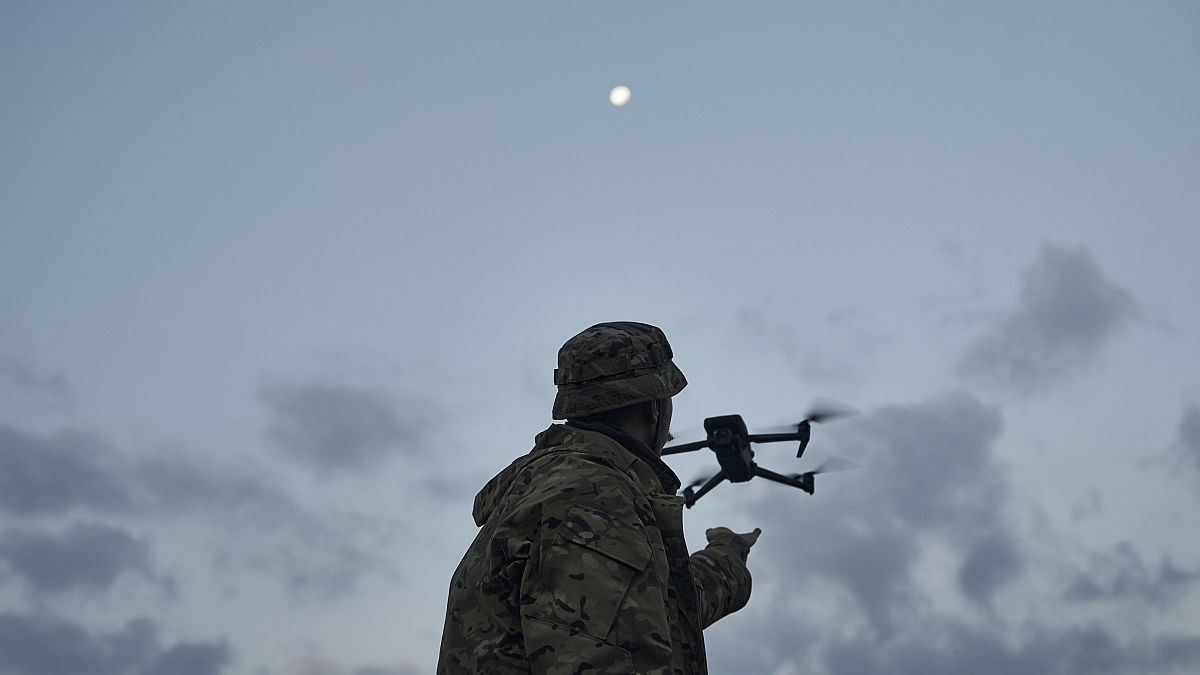New jam-proof drones are being used in the war in Ukraine. Here’s the latest on how they work and how they may be used in the future.
The Russians are using a new type of drone against the Ukrainians amid an ongoing Kursk offensive that they claim makes "electronic warfare systems powerless".
Andrei Nikitin, governor of the Novgorod region of Russia, said on his Telegram channel earlier this month that fibre-optic drones called the Prince Vandal of Novgorod (KVN) are being used at scale in the operation against the Ukrainians.
The modified first-person view (FPV) drones deploy a super lightweight fibre-optic wire behind them as they fly, which makes them "almost indetectable" to the other side’s intelligence teams, according to James Patton Rogers, executive director of the Cornell Brooks Tech Policy Institute at Cornell University.
This comes as the drone war intensifies between both sides. Earlier this week, the Russians launched over 100 drones in various regions of Ukraine in an attack on the country’s energy systems.
Meanwhile, the Ukrainians launched what’s been described as their largest drone attack over Moscow last week as troops continue to push through the Russian line in the ongoing Kursk offensive.
How do these drones work?
A Ukrainian military blogger, Serhii "Flash" Beskrestnov, found one of the Russian fibre-optic drones on the frontlines in March.
He described it on Telegram as a first-person view (FPV) drone with a strange plastic on top that had roughly 10.8 km worth of fibre-optic cable inside.
The fibre-optic cable is in the place where a transceiver, which receives and transmits radio signals, normally sits on other FPV drones.
Noah Sylvia, a research analyst on emerging tech at the UK’s Royal United Services Institute (RUSI), said flying a drone without this transmitter means it does not emit any radio signals that can track the drone's location or its operator.
Experts can identify that the Russians are using fibre-optic because, unlike regular FPV drones, the cables provide a high-quality video back to the operator that doesn’t fuzz out when there is interference, Sylvia said.
Yet there are some possible setbacks to this technology.
Unlike FPV drones which are light and limited by the weight they can carry, the new drones will need more battery power or stronger engines to compensate for the heavy fibre-optic cable, Sylvia said, which could make them much more expensive to make.
There’s also a risk that the extra weight slows these drones down and limits their range compared to untethered drones, Rogers said.
FPV drones "can go quickly, they can do sharp angles and be very manoeuvrable and come at angles that the enemy isn’t anticipating," Sylvia said. "The wire limits that some".
Why is Russia using them?
On August 6, the Ukrainians launched a surprise offensive into Russia’s Kursk region. The ongoing mission led the Ukrainians to advance up to 35 km into the Russian line, control over 90 settlements, and capture "hundreds" of soldiers, according to the Kyiv Independent.
Part of the Ukrainians’ initial success during the offensive was using different types of electronic warfare that disabled Russian surveillance, Sylvia said, which meant they were able to get further into Russian territory.
One way for the Russians to counter that is by deploying fibre-optic drones en masse, Sylvia continued.
"I think that’s why fibre-optic cable has been used more, because we haven’t seen the Ukrainians use electronic warfare in a manoeuvre setting like this before," he said.
Euronews Next reached out to the Ukrainian military to see if they are using a similar fibre-optic drone in their fleet but did not receive a reply by the time of publication.
HIGHCAT, a German drone manufacturer, told Forbes this month that they developed a similar drone called the HCX with the developments in Ukraine in mind and will be demonstrating it there.
A description of the drone on HIGHCAT’s website says the HCX is "suitable for missions in highly jammed areas," by attaching glass fibre spools to the drone. When done, the drone can "fly undetected" because no radio signal is emitted.
If the testing is successful, HIGHCAT toldForbes they could start production of up to 3,000 drones a month starting in November.
A 'supplement' to robust drone fleets
Both sides have small, medium, and large drones in their arsenal, Sylvia said.
The large drones that fly up to 10,000 feet (3,048 km) and above are used for surveillance, GPS jamming, and capturing signals coming from the enemy to locate them.
The medium-sized drones that go up a "couple thousand feet" are used to "scan enemy terrain" or coordinate artillery fire, he said.
The smaller drones like the FPV drones are considered "kamikaze drones" because they’re flown directly into an enemy target, Sylvia continued.
Rogers said both militaries will be watching to see how these drones perform on the battlefield because if they provide a "stealth-like tactical advantage for Russia," then both sides will start using them more often.
Even if that’s the case, Sylvia believes fibre-optic drones will not revolutionise how war is being fought because the drones are modifying a type of technology used in other weapons, like the US’ tube-launched, optically tracked, wire-guided (TOW) tank missiles that make up part of Ukraine’s arsenal.**
Instead, what will likely happen is these drones will be used "as a supplement," to the already robust drone fleets on both sides, he said.
It’s too soon to know what the countermeasure will be against them, Sylvia continued, but he could see them "being shot down with bullets or missiles or other drones".
"People have a lot of ingenuity during wartime, and I guarantee there will be a countermeasure to this if there isn’t one already," he said.
As of right now, Rogers says it’s hard to discern who has the upper hand in the drone war because it’s a "game of cat and mouse" with each side trying to counter the other’s newest innovation.















